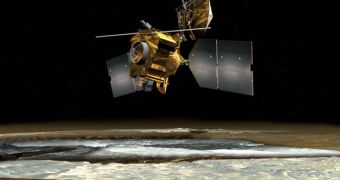Officials at the American space agency announce that one of their orbiters around the Red Planet has just suffered another error, and has as such entered safe-mode.
Computers on spacecraft are designed with such features specifically to prevent the loss of total control on the instruments and propulsion systems aboard.
Whenever a glitch occurs in computer circuits or software, the onboard systems reboot and enter safe mode, awaiting further instructions from ground controllers.
This is what happened to the Mars Reconnaissance Orbiter, a powerful NASA spacecraft that has been in orbit around Mars for several years, conducting surveillance studies on the planet.
An error forced the computers aboard the MRO to reboot suddenly on September 15, for reasons that were not diagnosed yet, Space reports.
This is the fifth time in less than two years that the orbiter is hampered by computer reboots. However, until now, mission controllers have been able to “revive” the spacecraft every time.
According to NASA officials, this instance will be no exception. Most likely, the MRO will be up and running, so to speak, within a couple of weeks at most.
Since being launched in August 2005, the spacecraft has been conducting invaluable research on Mars, and fulfilling two highly important objectives.
The first is acting as a relay for the Spirit and Opportunity rovers, which have been trekking on Mars for the past six and a half years.
The second one is to map the surface of our neighboring planet, in search for a landing spot suitable for the next rover mission, the Mars Science Laboratory (MSL), now called Curiosity.
MRO took about $420 million to build, which makes it relatively cheap as far as space missions go. For the money invested in it, the orbiter has returned numerous benefits.
One of its main scientific instruments, the High Resolution Imaging Science Experiment (HiRISE) camera, has snapped thousands of highly-detailed pictures of the Red Planet's surface.
Several interesting landscapes have been discovered, such as spider-like features and peculiar sand dunes.
Continuing these efforts is essential for the MRO mission managers, who are based at the NASA Jet Propulsion Laboratory (JPL), in Pasadena, California.
We will publish more details as the situation unfurls, so keep an eye on this space for more.

 14 DAY TRIAL //
14 DAY TRIAL //